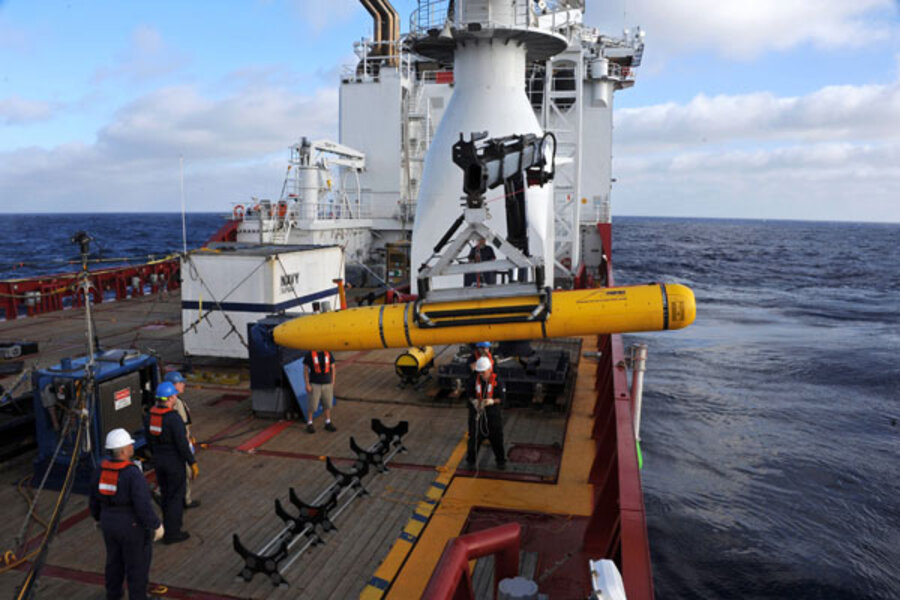Military ramps up use of underwater drones. What do they do?
Loading...
They can range from a svelte 100 pounds to several thousand. They can be snub-nosed, bullet shaped brutes that can dive six miles deep or buoyancy-propelled machines that can gracefully glide for several months at a time. And they can perform a myriad of tasks ranging from tracking pollution to mapping terrain for oil and gas exploration.
They are autonomous underwater vehicles (AUVs), the aquatic answer to the airborne drones that track terrorists in Yemen and, if Amazon has its way, could be delivering DVDs and dog food to your back patio.
AUVs gained some measure of public awareness when a Bluefin drone was sent to look for the missing Malaysia Airlines Flight 370 in the southern Indian Ocean earlier this year. Like their airborne cousins, they can perform a variety of tasks, both scientific and civilian. But also like their airborne cousins, AUVs are finding that their biggest customers are militaries.
Vast acres of underwater canyons, ledges, and plateaus offer a hide-and-seek playground for submarines and unmanned vehicles to engage in combat maneuvers without even a surface ripple to give the game away. To navies worldwide, AUVs are intriguing as mine-sweepers and potential entrants into antisubmarine warfare. Like aerial drones, they could also help countries project force far away without risking the lives of sailors.
Critics say the technology needed to build effective drones is inherently more difficult underwater than in the air, limiting the impact that AUVs might have. But at least 630 AUVs are already prowling global waters, and the trend line is undeniably upward.
“All of this … suggests that sustaining the advantage undersea will be very, very important in the future and that robotics are a very significant way to continue that,” says Paul Scharre, an analyst at the Center for New American Security in Washington.
Unlike remotely controlled vehicles that are often used for salvage missions and are attached to a ship, AUVs are untethered, carry their own power supply, and are self-guided. They get their instructions, are released from a platform such as a surface ship, and travel to pre-programmed destinations. At the moment, military demand accounts for more than 60 percent of AUV production.
The global AUV fleet is forecast to increase 42 percent from 2014 to 2018 and will “total 825 units in 2018, led by strong demand in the military sector,” according to market research consultants Douglass-Westwood. Global expenditures on AUVs are expected to total $2.3 billion during the next decade, according to 2012 figures.
At this point, what AUVs can do is partially limited by what they can't do well. Sensor accuracy and battery power are severely tested underwater, and communications are limited by delays for data transfer, says John Craig, a professor at the United States Naval War College in Newport, R.I.
“It’s just a lot harder to transmit the prediction of sound [performance] through the sea than it is to predict radar through the air or to control things once they’ve left the surface of the sea,” he says.
Even with these limitations, though, AUVs are in many ways ideal as mine-sweepers, able to do initial reconnaissance and clear a lane for a ship to pass without putting divers in harm's way. Last October, the US Navy awarded awarded a five-year, $36.5 million contract to Hydroid, Inc., a subsidiary of Kongsberg Maritime and considered a world leader in AUV technology, for underwater vehicles specifically for mine countermeasures (MCM).
“There’s actually multiple navies around the world either experimenting or doing initial work with AUVs in that field," says David Kelly, CEO of Bluefin Robotics, a subsidiary of Battelle Corp. and another player in the underwater robotics industry. "We have products with over 16 different navies around the globe in the MCM realm.”
Antisubmarine warfare (ASW) is another key area where analysts say unmanned underwater vehicles will play an increasingly greater role. ASW, often said to be the “linchpin of sea control,” isn’t just one activity but many. It can include placing and monitoring sensors on the sea floor to track enemy subs, or stalking and destroying enemy subs using the coordinated efforts of submarines, surface vessels, and aircraft.
AUVs' limitations mean they aren't yet ready to be deployed fully and seamlessly into that network yet. But in time, underwater vehicles could be controlled and enabled to work cooperatively with submarines and surface vessels, says Mr. Scharre of the Center for New American Security.
Indeed, a 2009 report by the defense consultancy Rand Corp. identifies ASW as the third most promising area for unmanned undersea vehicles, right after mine countermeasures. No. 1 was intelligence, surveillance, and reconnaissance.
Undersea activity as a whole is vital to how the United States considers the question of power projection, says Scharre. With other countries now acquiring long range, antiship ballistic missiles and cruise missiles capable of targeting both ships and US bases, it is becoming harder to project power from traditional aircraft carriers or air bases, he says. But undersea still offers the sanctuary to get in close to an enemy’s shoreline to project power.
The races to deploy and effectively use undersea drones is on, says a 2014 report by the Center for a New American Security. “At least 75 countries are investing” in unmanned systems, it says. “While the US military has thousands of unmanned systems of different types … these largely remotely piloted air and ground vehicles will soon be replaced by increasingly autonomous systems in all physical operating domains (air, sea, undersea, land and space) and across the full range of military operations.”





